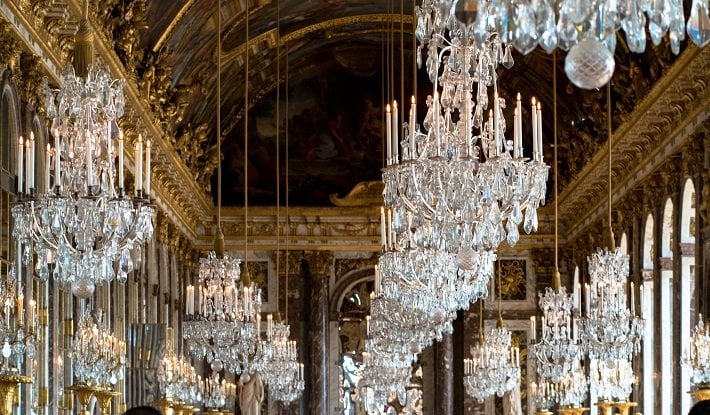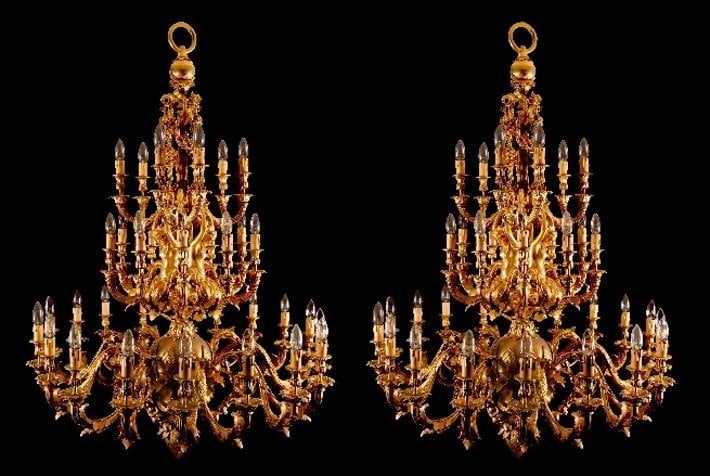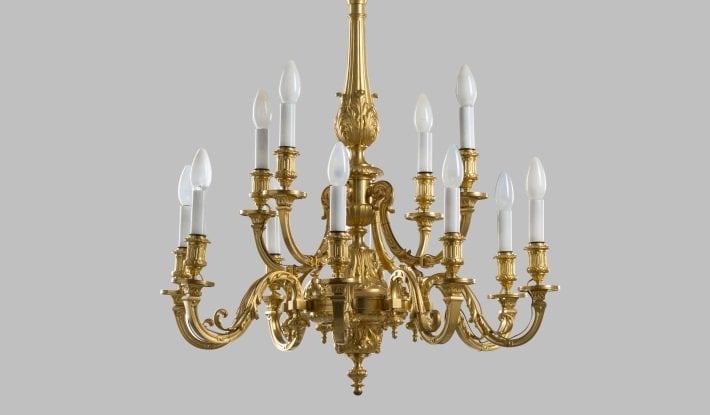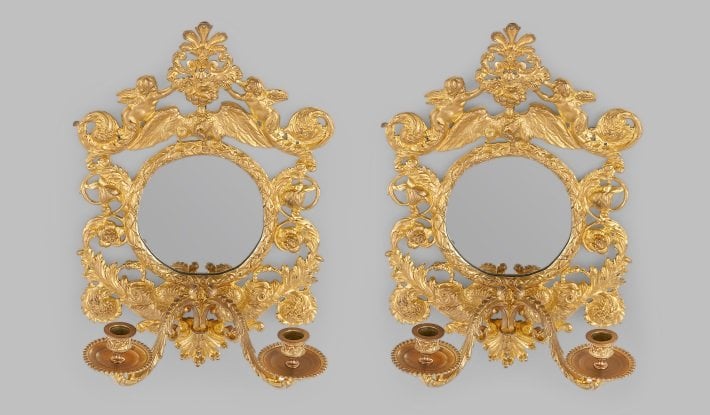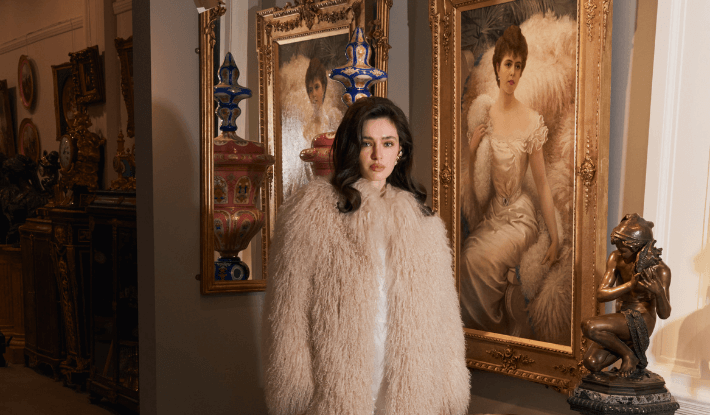Since the dawn of creation, the earth has enjoyed the light of day provided by the sun, and the contrasting darkness of night.
In the modern and developed world, we can access light at will – through the flick of a switch or even via our mobile telephones and other electronic devices.
Artificial lighting dominates our lives, making it difficult for us to imagine just how limited our ancestors were once the dark of night fell.
The advances that humanity has made in the realm of lighting – from the kindling of fire to the complex electrical lighting of the 21st Century – are astonishing. The Mayfair Gallery Guide to Lighting explores and explains this incredible history, and reveals how lighting has transformed from a practical necessity to a luxurious form of art.
Controlling fire and the origins of lighting
The sun has been the primary source of light since the dawn of the universe. In prehistoric times, the rising and setting of the sun controlled when all activities – from hunting to travelling – could take place.
All this changed when humanity discovered the power of fire. By harnessing the sun’s energy and burning raw materials, suddenly the end of the day did not have to occur with sundown.
Instead, rudimentary flaming torches could be used to provide a portable light source, which also gave out heat energy, meaning that human activity could continue into the darker and colder hours of the night.
Our ancestors' existence and livelihoods were utterly transformed, particularly in the winter months.
The discovery of fire was revolutionary, and the history of humanity was forever altered.
The earliest humans were now able to cook, warm themselves, and create light, all by rubbing natural objects, such as twigs and flint, against one another.
The first lamps
Across the world, archaeological discoveries have been made of the very first ‘lamps’, which date to around 70,000 BC. These objects, which appear so simple, actually represent a huge development in the history of lighting.
Made from hollowed out containers such as shells or rocks, the lamp bases were then filled with dried grass and wood. Animal fat was sprinkled over the natural kindling and ignited.
These first lamps allowed for the light source - fire - to be more contained and controlled in a smaller area. However, the primitive lamps also had their drawbacks, as they burnt out quickly and had to be constantly tended to and re-fuelled.
The next major breakthrough in the history of lighting thus came in the form of the oil lamp. These small lighting devices were first made in about 4500 BC and were common in ancient Egypt and Greece, and then later in Rome.
Made from a range of materials – including alabaster, bronze and terracotta – these lamps were crafted in the shape of a dish to hold oil, with space for a wick to prolong burning and make the lamps reuseable.
In contrast to the light produced from natural kindling in open vessels, by burning oil in lamps the power of fire and light could be more controlled, as it was in an enclosed space.
An additional benefit to the oil lamp was its portability, as these light sources usually had a handle and were much safer to carry than flaming torches.
Fascinatingly, these early oil lamps are thought to be the first mass produced objects in history, showing just how valued, important and desired a commodity light was considered to be.
Despite the developments in lighting and the creation of the oil lamp, it is clear that ancient people were still heavily reliant on the sun as a source of light. Roman houses had an open atrium at their centre to allow the greatest amount of light in.
The open structure of an atrium let in a great deal of natural light, providing more brightness than a single oil lamp could.
The first candles
At the same time as oil lamps were being burnt, so too were the very first candles being created.
Invented in the early centuries BC, the development of candles was the next important moment in the history of lighting.
Initially made from animal fat, candles had the advange of providing more light than oil lamps and could be burnt for longer.
Interestingly, although evidence of candles has been found in ancient Greece and Rome, their use in these societies was never as widespread as oil lamps.
The reason for this is unknown, although one possible explanation is the preference for the odourless burning of oil in contrast to the unpleasant smell of burning animal fat candles.
It was in Asia that candles came to the fore and were used widely as the primary artificial light source. The earliest surviving examples of candles from Asia are believed to have been created around 200 BC, and were made from whale fat.
In India, candle wax was made from boiling cinnamon. The material formed a thick paste, which was then cooled and set, and could be burnt down with a wick at its centre.
In effect, the craftsmen of ancient India had - quite by chance - created the very first example of the scented candle, an object that is associated with luxury and indulgence in our modern world.
Back in Europe, after the collapse of the Roman Empire, trade shrunk and oil became more difficult to obtain. As a result, candles rather than oil lamps became the most common source of light across Europe during the Middle Ages.
For the fortunate, wealthy Europeans, beeswax candles were readily available. These fine candles burned cleanly, without an odour or an excess of smoke.
The oldest surviving beeswax candles, dating to the 6th-7th Centuries AD. © Bullenwächter via Wikimedia Commons
But beeswax was hugely expensive in medieval Europe, and only the very rich – or the church – could afford to burn beeswax candles in their homes.
For the unlucky poor, a cheaper, nastier light source was available: the tallow candle.
Tallow candles were made from animal fat, and emitted a foul odour of meat when burned. These long, gently-curving lights were often formed by dipping a strip of fabric or rope in molten fat, waiting for it to dry, and then repeating the process to build up thick layers of tallow that could be burnt down.
To double the illumination, the tallow candles could be lit from both ends, although the quality of light these rudimentary devices emitted was still incredibly poor. Moreover, the majority of activity still had to occur during the hours of daylight because tallow candles burnt out so fast – some as quickly as twenty minutes.
Despite their disadvantages, tallow candles were certainly more economically viable than their beeswax rivals. The slaughter of one bullock could provide enough tallow for at least three years' worth of candles, and these could be made at no additional expense by family members.
Although candles could be held by hand, candlesticks were a common sight in European medieval households, for both rich and poor. The first examples of these were simply designed structures of metal or wood with vertical spikes, or prickets, on which candles could be secured.
Three champleve enamel on copper pricket candlesticks from the 13th Century, held at the Taft Museum of Art. © Forever Wiser via Flickr
The cheapest of these were simple wooden prickets; more expensive prickets or candleholders made of pewter or silver were found in households of the rich.
But for both rich and poor, the danger of candles was present: in an age that combined frequent use of candles with timber-framed houses, accidents of fire were common.
The first chandeliers
Developments occured in the Renaissance period, when simple candleholders became more complex.
Owing to the poor quality of light provided by a single flame, candles would be placed side by side, which led to the creation of both branched candelabra and chandeliers.
Candles were also placed in holders that were attached to the wall, in simple sconces to provide illumination in dark corridors.
And so, the wealthiest patrons begun to place their beeswax candles in heavy dark metal or wooden frames, often decorated with Gothic motifs and heraldic shields.
These frames would then be hung from the ceiling, in order to better illuminate the whole room and avoid the danger of knocking over candles.
Illustration of a Medieval chandelier from King Rene’s Tournament Book, 1460
While chandeliers are associated with luxury and grandeur in today's world, it is likely that these earliest creations would have been very simple affairs, the concerns being practical rather than aesthetic.
In the 15th and 16th Centuries, more complex chandeliers based on ring or crown designs became popular decorative features in palaces and homes of the nobility, clergy and merchants.
Owing to these more ornate and expensive designs, the chandelier became symbolic of high status and luxury; a reputation similar to the one it enjoys today.
Thus, in the Renaissance period, lighting and lighting fixtures became more than simply practical concerns. Instead, greater attention to visual detail was paid, and for the first time candlelight became associated with beauty, as well as necessity.
18th Century lighting
The importance of appearance: glittering glass and the Versailles effect
Despite the advances made during the Renaissance, it wasn’t until the late 17th and 18th Century that fundamental improvements took place in the development of lighting.
As technological advances occurred, so too did decorative ones.
The 18th Century in particular saw a huge rise ornamental lighting, as form began to be regarded as important as function.
Suddenly, the wealthier classes wanted to prioritise the aesthetics of a light source, rather than just ensuring the functionality of it.
Attention was paid to how light looked and felt, and importance was placed on creating a pleasant ambience in an interior.
By the early 18th Century, long gone were the simple medieval frame chandeliers, candlesticks and sconces. In their place were ornate, gilded forms with long, curved branches and the capacity to hold many candles.
Pair of early 20th Century gilt bronze (ormolu) chandeliers, beautifully decorated in the Rococo style. Inspired by chandelier designs from the 18th Century, note the ornately decorated, scrolling arms and the large quantity of light branches to maximise illumination
For both candelabra and chandeliers, the inclusion of branches that began at a central point and extended out represented a radical new style.
The novel form was a complete departure from the preceding designs, and was a hugely significant development in the history of lighting. With branches to support candles, light could be now spread more widely and evenly across a room, thus creating a stronger illumination over a greater distance.
However, the reasons for these new, larger forms of lighting fixture were not solely practical, but also aesthetic. Often cast in gilded metals or carved wood, golden lighting fixtures provided an atmosphere of royal grandeur and wealthy indlugence.
Carved and gilded chandeliers became immensely popular in the 18th Century, partly because they could be made to imitate incredibly expensive pieces in royal households made of solid gold and silver.
Indeed, so important and highly regarded was lighting that in the grandest of European aristocratic houses lamps and light fittings required their own room, designated for their cleaning.
Moreover, the gold features augmented and enhanced the emission of light: the decorative golden lustre reflected candlelight beautifully, creating an atmosphere of luxury and warmth. Seamlessly blending form and functionality, the 18th Century lighting designs are hugely significant in the history of lighting.
19th Century antique gilt bronze (ormolu) chandelier by famous French maker Ferdinand Barbedienne. Gilt bronze was an exceptionally popular choice of material for lighting fixtures, as the beautiful gold colour reflected and illuminated the candlelight
The styles of such lighting fixtures also reflected the fashion of the time, and new works were created in the Baroque, Rococo and Neoclassical trends of the 18th Century.
Classical motifs became an increasingly important element of 18th Century lighting fixtures, and candelabra, wall lights and chandeliers all drew heavily on the aesthetics of ancient Greece and Rome.
The incorportation of Louis XVI style clean lines, harmonious proportions and swirling foliate motifs such as achanthus leaves were particularly popular in late 18th Century chandelier design.
Although interiors lit by candlelight required many individual candles to create enough light, 18th Century craftsmen realised that this light could be intensified by clever design techniques.
One of these was, of course, the method of gilding bronze and wood to reflect the candlelight. In addition, 18th Century craftsmen also began experimenting with glass, crystal and mirrors to enhance interior lighting.
Pair of gilt bronze (ormolu) and cut glass Belle Epoque style chandeliers, made in Bohemia
One obvious advantage to using glass and crystal for chandeliers was that these materials were transparent. Fine, clear cut glass and crystal thus allowed for light to shine through it and be reflected, creating further illumination and beauty. During the 18th Century, the finest cut glass chandeliers were produced by Bohemian and Venetian glassmakers.
The Bohemian style was largely successful across Europe, and became famous for creating spectacular illumination due to the reflection of candlelight from intricate crystal prisms.
To compete with the Bohemian glassmakers, Italian glass factories on the Venetian island of Murano created new kinds of artistic light fittings.
Typical features of a Murano chandelier are the intricate foliate details including leaves, flowers and fruits. The appearance of these were enhanced by coloured glass.
Early examples have plain arms set around a heavy central ball, gradually they became more elaborate and towards the middle of the 18th Century, pendants and drops were used.
As the hanging drops swayed gently with every current of passing air, the gleam of candles and firelight was reflected in the sparking crystals and glass to create a glittering appearance.
The magnificent Hall of Mirrors in the Palace of Versailles, Paris. © Myrabella via Wikimedia Commons
The attractive warm glow of gold light fittings was enhanced by the use of mirrors, which further reflected and radiated candlelight.
One of the most important examples of an interior that was designed to cleverly maximise the appearance of candlelight is the Hall of Mirrors in the Palace of Versailles, Paris.
This stunning room is the first example of a large scale combination of glass, crystals, rich, golden colouring and - most importantly - mirrors, to dramatically improve the ambience of a setting.
In fact, the hall’s large expanse of mirrored glass reflected candle-light so effectively that the French court began for the first time to hold regular evening parties there. The visual effect was a magical, star-like one, creating an atmosphere of ethereal beauty and warmth.
A fashion was created for mirrored wall lights that lasted well into the 19th Century, as demonstrated by these charming wall lights made of gilt bronze. With mirrored backs, the pair beautifully reflect the glowing light when candles are placed in their holders.
Pair of 19th Century Rococo style gilt bronze wall lights, with mirrored backings
19th Century lighting
In the 19th Century, lighting fixtures continued to take inspiration from earlier designs.
Neoclassical, Rococo and Baroque style works remained popular, as did the creation of works using cut glass, mirrors and golden gilted materials to augment the appearance of candle and firelight.
Importanly, the rise of a growing, wealthier middle class across Europe meant that desire to own more decorative internal lighting fixtures was stronger than ever. Particularly important was the use of gas lighting, which was developed at the end of the 18th Century.
The invention of gas lighting also meant that larger scale, public lighting could now be used. The first public street lighting was demonstrated in 1807 on the streets of London. It was a gas-lit lamp, as the majority of lamps for the next century would be.
Gas street lighting wasn’t widely available until the mid-19th Century and most early street lamps were placed almost 100m apart from one another. The street lamps thus provided points to aim for along the route, rather than providing continuous illumination.
So despite the presence of street lamps in London, the lighting levels were still extremely poor. Crime remained rife under the cover of darkness, and drunkenness, prostitution and violence were common occurrences.
However, while the quality of light remained poor on the streets of European cities, interior lighting was radically improved.
Although very wealthy Europeans could afford gas lighting from the beginning of its production, it wasn’t until the 1840s that the middle and merchant classes began to move away from candlelight and convert their chandeliers to gas.
This transition represented a huge change: no longer did people need to keep tending to candles throughout the evening, instead light could be controlled by a simple turning of a switch.
So excited were people by the new invention of gas lighting, that it became fashionable to close the shutters and draw the curtains even during daylight hours, so that the gas lamps could be showed off to better effect.
Gas lighting provided an incredible improvement to people’s ability to read, write or sew in the evenings with minimal effort.
It nevertheless had many drawbacks: there were frequent explosions, and it created sooty, black deposits over the lighting fixtures deposits. Indeed, Victorian ladies frequently fainted because of a lack of oxygen in their gas-lit drawing rooms.
For the poor however, candles remained the order of the day, and the mass production of candles meant that they became much cheaper and more readily available.
The late 19th Century and the electric light
In 1879 a major lighting breakthrough was made by Sir Thomas Edison, who invented the carbon filament light bulb. This caused a huge stir, and revolutionised lighting techniques all over the world.
The carbon filiament lightbulb. © Hannes Grobe via Wikimedia Commons
In the 1880s, electric lighting was immensely expensive and therefore very highly prized and fashionable.
For example, in the late 19th Century a single light bulb cost the same as the average week’s wages. On top of which, a personal home generator was required to run the electric lights at further enormous expense.
However, the boom of wealth enjoyed by the United States at the time meant that several millionaire New York residents were able to install electricity generators in their houses.
So excited were people about the electric light that it infiltrated all aspects of society: a certain Mrs Cornelius Vanderbilt, for example, even went to a costume ball dressed as an electric light bulb.
But a huge problem with the first electric light systems was their lack of safety. In fact, the very same Mrs Vanderbilt – once so enthusiastic about the carbon filament lightbulb – had the electrical system in her home removed after it caught fire.
Mrs Cornelius Vanderbilt dressed in her 'Electric Light' costume at the Vanderbilt Ball in 1883, photographed by Jose Maria Mora
It would take nearly a century more for the true power of electric lighting to be harnessed. And although electric lighting phased out candles in many parts of the world, candlesticks and candelabra remain an important decorative element, adding a beautiful atmosphere and a touch of elegance to an interior space.




